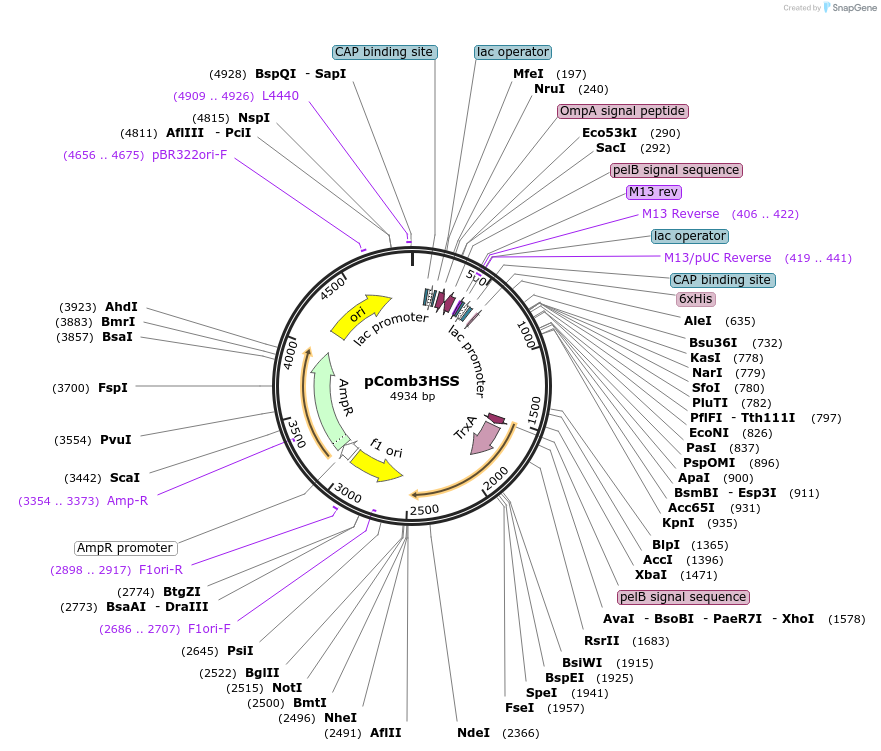-
Purpose2nd generation plasmid for phage display on modified geneIII, contains stuffer fragment
-
Depositing Lab
-
Sequence Information
Ordering
| Item | Catalog # | Description | Quantity | Price (USD) | |
|---|---|---|---|---|---|
| Plasmid | 64133 | Standard format: Plasmid sent in bacteria as agar stab | 1 | $89 | |
Backbone
-
Vector backbonepComb3
- Backbone size w/o insert (bp) 3300
- Total vector size (bp) 4900
-
Modifications to backbonechanges to the cloning cassette including the order of the antibody cloning sites, replacing one pelB leader with ompA, improvements to stability
-
Vector typeBacterial Expression ; phage display
Growth in Bacteria
-
Bacterial Resistance(s)Ampicillin, 100 μg/mL
-
Growth Temperature37°C
-
Growth Strain(s)XL1 Blue
-
Copy numberHigh Copy
Gene/Insert 1
-
Gene/Insert nameSS Stuffer
-
Alt nameSfiI Stuffer
-
SpeciesSynthetic
-
Insert Size (bp)1600
- Promoter lacZ
-
Tag
/ Fusion Protein
- geneIII (C terminal on backbone)
Cloning Information for Gene/Insert 1
- Cloning method Restriction Enzyme
- 5′ cloning site SfiI (not destroyed)
- 3′ cloning site SfiI (not destroyed)
- 5′ sequencing primer 5'-AAG ACA GCT ATC GCG ATT GCA G-3'
- 3′ sequencing primer 5'-GCC CCC TTA TTA GCG TTT GCC ATC-3'
- (Common Sequencing Primers)
Gene/Insert 2
-
Gene/Insert nameLight Chain Stuffer
-
SpeciesSynthetic
-
Insert Size (bp)1200
Cloning Information for Gene/Insert 2
- Cloning method Restriction Enzyme
- 5′ cloning site SacI (not destroyed)
- 3′ cloning site XbaI (not destroyed)
- 5′ sequencing primer 5'-AAG ACA GCT ATC GCG ATT GCA G-3'
- 3′ sequencing primer 5'-CGG CTG CCG TAG GCA ATA GGT-3'
- (Common Sequencing Primers)
Gene/Insert 3
-
Gene/Insert nameHeavy Chain Stuffer
-
SpeciesSynthetic
-
Insert Size (bp)300
Cloning Information for Gene/Insert 3
- Cloning method Restriction Enzyme
- 5′ cloning site XhoI (not destroyed)
- 3′ cloning site SpeI (not destroyed)
- 5′ sequencing primer 5'-ACC TAT TGC CTA CGG CAG CCG-3'
- 3′ sequencing primer 5'-AGA AGC GTA GTC CGG AAC GTC-3'
- (Common Sequencing Primers)
Terms and Licenses
-
Academic/Nonprofit Terms
-
Industry Terms
- Not Available to Industry
Trademarks:
- Zeocin® is an InvivoGen trademark.
Depositor Comments
pComb3H is the second generation of pComb vector. Improvements over pComb3 include increased stability and introduction of a new cloning region utilizing asymmetrical SfiI restriction sites for directional cloning of full Fab, scFv, peptide and other proteins for phage display. The “SS” refers to the double stuffer, a 1200bp stuffer in the Fab light chain cloning region bounded by SacI and XbaI restriction sites and a 300bp stuffer in Fab heavy chain cloning region bound by XhoI and SpeI restriction sites. Also, the 1600bp double stuffer (both stuffers plus the leader sequence between the Fab light chain and heavy chain cloning regions) can be removed by SfiI digest so that non-Fab genes of interest can be cloned. Soluble Fab can be expressed by removing the gene for the pIII phage fusion protein by SpeI/NheI digest. Sufficient soluble protein is also found in the periplasmic space as a result of proteolysis. Also available from Addgene: pComb3HTT, includes the human Fab to tetanus toxin that can be used as a phage display and protein expression control and pAraH6HATT, an arabinose inducible protein expression plasmid containing a pComb3H compatible SfiI cloning cassette and tags for detection of non-Fab proteins.
Select References:
Cary, S.P.; Lee, J.; Wagenknecht, R.; Silverman, G.J. (2000) Characterization of Superantigen-Induced Clonal Deletion with a Novel Clan III-Restricted Avian Monoclonal Antibody: Exploiting Evolutionary Distance to Create Antibodies Specific for a Conserved VH Region Surface. J. Immun., 164, 4730-4741.
Tanaka, F., Barbas III, C.F. (2001) Phage display selection of peptides possessing aldolase activity. J. Chem. Soc., Chem. Commun. 8:769-770.
Rader, C.; Cheresh, D.; Barbas III, C.F. (1998) Phage display approach for rapid antibody humanization: Designed combinatorial V gene libraries. Proc. Natl. Acad. Sci. USA, 95, 8910-8915.
Steinberger, P.; Sutton, J.K.; Rader, C.; Elia, M.; and Barbas III, C. F. (2000) Generation and Characterization of a Recombinant Human CCR5-specific Antibody: A Phage Display Approach for Rabbit Antibody Humanization, J. Biol. Chem., 275,36073-36078.
Rader, C. and Barbas III, C.F. (1997) Phage Display of Combinatorial Antibody Libraries. Current Opinion in Biotechnology 8, 503-508.
Rader, C.; Ritter, G.; Nathan, S.; Elia, M.; Gout, I.; Jungbluth, A.A.; Cohen, L.S.; Welt, S.; Old, L.J.; Barbas III, C.F. (2000) The rabbit antibody repertoire as a novel source for the generation of therapeutic human antibodies.J. Biol. Chem., 275, 13669-13676.
Segal, D.J.; Dreier, B.; Beerli, R.R..; Barbas III, C.F. (1999) Towards controlling gene expression at will: Selection and design of zinc finger domains recognizing each of the 5’ - GNN-3’ DNA target sequences. Proc. Natl. Acad. Sci, USA, 96, 2758-2763.
Wu, H., Yang, W.-P., and Barbas III, C.F. (1995) Building Zinc fingers by selection: Towards a therapeutic application. Proc. Natl. Acad. Sci. USA, 92:344-348.
Yang, W.-P., Green, K., Pinz-Sweeney, S., Briones, A.T., Burton, D.R., and Barbas III, C.F. (1995) CDR Walking Mutagenesis for the Affinity Maturation of a Potent Human anti-HIV-1 Antibody into the Picomolar Range. J. Mol. Biol. 254:392-403.
These plasmids were created by your colleagues. Please acknowledge the Principal Investigator, cite the article in which the plasmids were described, and include Addgene in the Materials and Methods of your future publications.
-
For your Materials & Methods section:
pComb3HSS was a gift from Carlos Barbas (Addgene plasmid # 64133 ; http://n2t.net/addgene:64133 ; RRID:Addgene_64133) -
For your References section:
Synthetic Human Antibodies: Selecting and Evolving Functional Proteins Methods, A companion to Methods in Enzymology 8, 94-103. Barbas CF, Wagner J. Methods, A companion to Methods in Enzymology, 1995; 8(2): 94-103. 10.1006/meth.1995.9997







